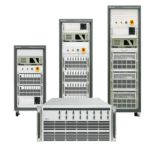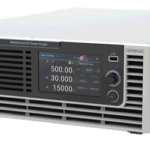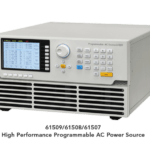
04 Mar Chroma 17010 Delivers 1mS Transient Sampling for Accurate EV Battery Testing
Advanced battery management systems (BMS) with real-time control strategies can ensure that EV batteries operate normally and within a safe range. Oftentimes, the BMS has a built-in equivalent circuit model (ECM, depicted in Figure 1), which accurately computes the battery’s state of charge (SOC), state of health (SOH), and state of function (SOF) through precise mathematical models.

▲Figure 1 – Battery Cell ECM
Voc: open circuit voltage; Ro:ohmic resistance; Rc1/Rc2: polarization resistance; C1/C2: polarization capacitance; IL: output current; VL: terminal voltage
The ohmic resistance (RO) in Figure 1 is an important indicator used to evaluate the output power of the battery. To obtain this parameter accurately, transient voltage and current changes must be captured with a sampling speed of up to 1mS at the instant of charging or discharging. Only then, it can effectively separate the ohmic resistance from the polarization resistance (RP) and polarization capacitance (CP). This also shows that the key to properly identify the ohmic resistance of an ECM is whether the charge/discharge equipment can capture transient voltage changes.
An ECM that reliably renders the actual state of the battery cell must use high-precision charging and discharging equipment to measure voltage, current, and temperature, as to identify accurate model parameters. Identification generally requires the hybrid pulse power characterization (HPPC) test waveform shown in Figure 2 to obtain the voltage and current characteristics, and then derive the ohmic resistance, polarization resistance, and polarization capacitance.

▲Figure 2 – HPPC Test Flow
Chroma 17010 charge and discharge test solutions attain 1mS transient sampling, which can accurately capture the transient changes throughout the electrical test, shown by the red circles in Figure 3. Combined with Chroma Battery LEx test software’s easy step editing, users can directly input SOC as the test point and quickly develop a complete HPPC test plan. The system then automatically calculates the RO and RP through the built-in variable definition function and the software’s arithmetic formula. The results are directly displayed in the test report for convenient application of such comprehensive testing.
With well over 30 years of experience in the field of precision test equipment, Chroma is the leader of automated test systems. The specialist in a wide range of power and electricity related test applications continuously rides the wave of developing trends in new energy. To this extend, Chroma is actively engaged in electric vehicles, energy storage systems, and other industries to provide a full range of test solutions.

▲Figure 3 – 1ms Transient Sampling Point in HPPC Test
Key Features
- High accuracy up to ±0.015% of F.S.
- Fast current response <100μS
- Single transient sampling rate up to 1mS
- High sampling rate up to 10mS
- Integrating up to 96CHs
- Channel parallel output up to 1200A
To learn more about this series, please go to the Chroma website through the following link:
Battery Reliability Test System Model 17010





